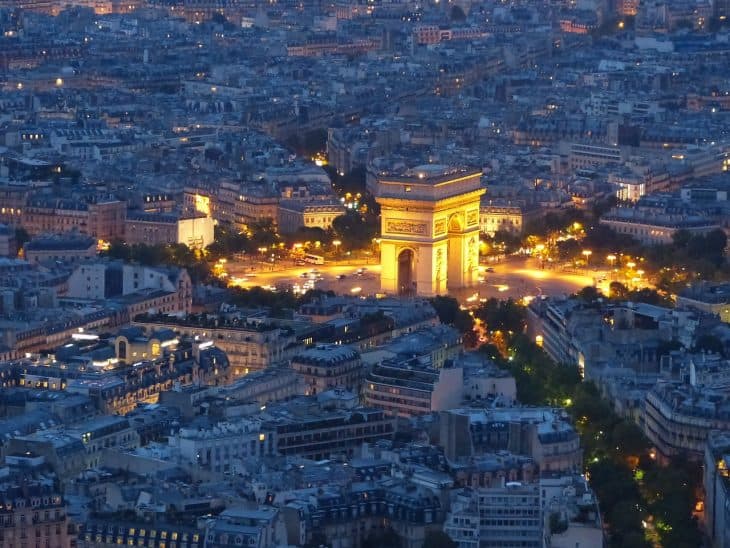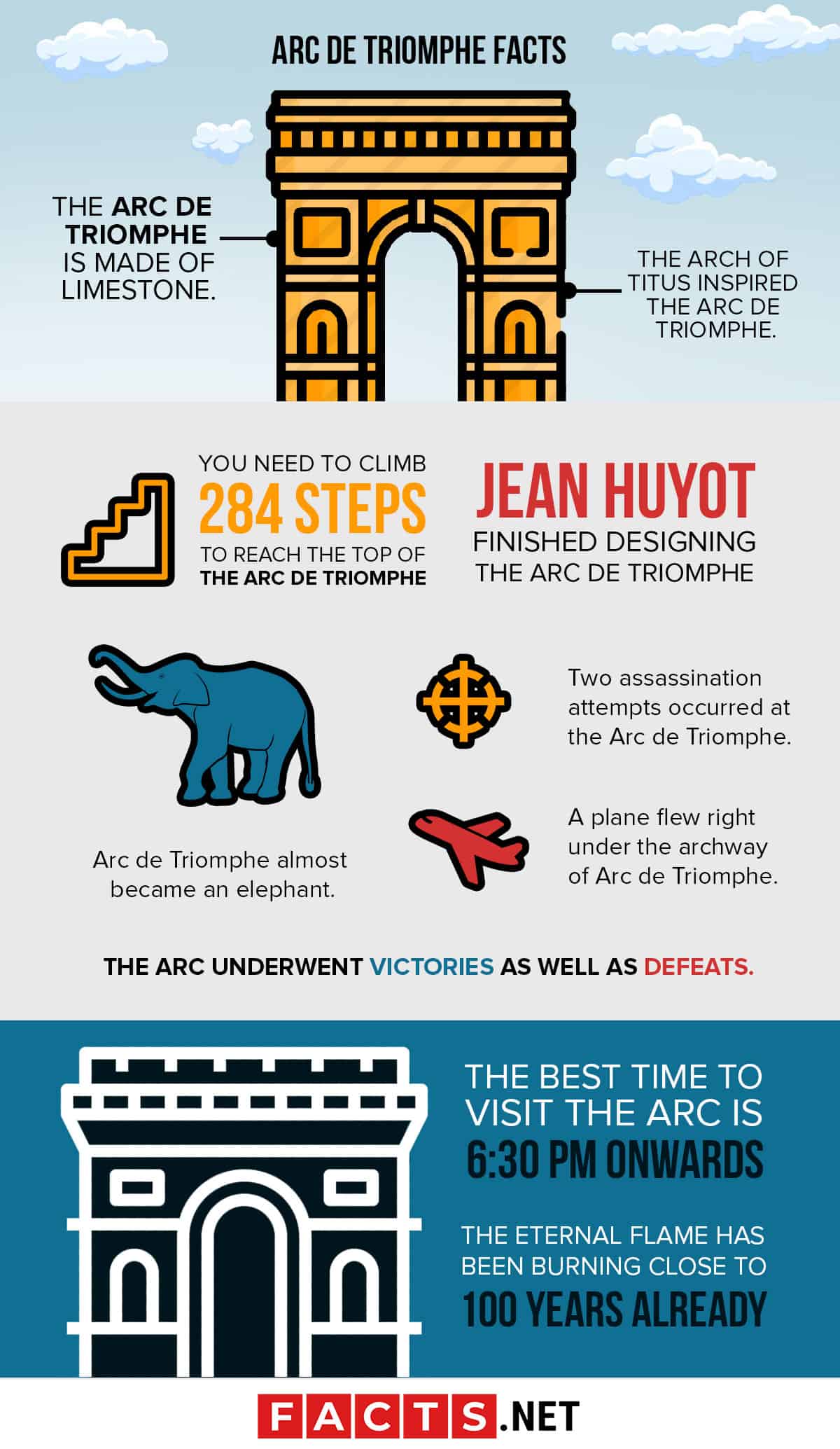
The Arc de Triomphe is one of Paris’s most recognizable landmarks, embodying France’s rich history and military triumphs. Commissioned by Napoleon after his victory at Austerlitz, this monumental arch honors those who fought and died for the country. It has since become a symbol of national pride, standing at the heart of Place Charles de Gaulle. From its intricate design to its role in significant events, the Arc continues to captivate millions of visitors each year. Here are 40 facts that reveal its importance and lasting legacy in French culture.
Arc De Triomphe Facts Infographics

Historical Background
- Commissioned by Napoleon
The arch was commissioned in 1806 after Napoleon’s victory at the Battle of Austerlitz. - Long Construction Process
Though construction began in 1806, it took 30 years to complete, with final touches added in 1836. - Architectural Influence
Designed by Jean-François-Thérèse Chalgrin, the Arc de Triomphe was inspired by the Arch of Titus in Rome. - Celebration of French Armies
Its purpose was to honor those who fought for France during the French Revolutionary and Napoleonic Wars. - Post-Napoleon Era
Despite being commissioned by Napoleon, the monument was completed under King Louis-Philippe, decades later.
Dimensions and Structure
- Imposing Height
The Arc de Triomphe is 50 meters (164 feet) high, making it a standout feature of Paris’s skyline. - Width and Depth
It spans 45 meters (148 feet) in width and 22 meters (72 feet) in depth, reflecting its massive scale. - Central Vault Size
The central vault of the arch is 29.19 meters (95.8 feet) high and 14.62 meters (48 feet) wide. - Military Sculptures
High-relief sculptures depicting historic military victories adorn the structure. - Four Major Sculptures
Among the four prominent sculptures is La Marseillaise by François Rude, representing the spirit of revolution.
Architectural and Artistic Details
- Detailed Reliefs
Numerous sculptors contributed to the Arc’s detailed reliefs, including Jean-Pierre Cortot and Antoine Étex. - Rosettes in the Vault
The ceiling of the vault is adorned with intricate caissons, each featuring decorative rosettes. - Over 660 Names Inscribed
The names of 660 individuals, primarily military leaders, are inscribed across the arch. - Shields of Victory
The attic section is engraved with 30 shields representing key victories from French military history. - Influence on Other Monuments
Its design has influenced triumphal arches worldwide, including structures in Pyongyang and Bucharest.
Cultural Significance
- Tomb of the Unknown Soldier
Beneath the arch lies the Tomb of the Unknown Soldier, added after World War I in 1921. - Eternal Flame
The flame of remembrance, rekindled every evening, serves as a tribute to fallen soldiers. - Annual Ceremonies
Every November 11, ceremonies commemorating the end of World War I are held at the arch. - Victory Parades
Major victory parades, such as those celebrating the end of both World Wars, have passed under the Arc de Triomphe. - Bastille Day Tradition
The annual military parade on Bastille Day begins here, a tradition cherished by the French.
Famous Events and Traditions
- Tour de France Finishes
The Tour de France bicycle race traditionally concludes near the Arc de Triomphe. - Protests and Celebrations
Throughout modern history, the site has seen numerous protests and celebrations. - Memorial to Prominent Figures
Coffins of notable individuals like Victor Hugo have lain in state beneath the arch before their funerals. - Gathering for National Pride
The Arc remains a gathering point for expressions of national pride, both in times of triumph and grief. - Symbol of Resistance
During World War II, the Arc de Triomphe became a symbol of French resistance to Nazi occupation.
Modern-Day Relevance
- Millions of Visitors Each Year
The Arc de Triomphe remains one of Paris’s most visited monuments, drawing millions of tourists annually. - Photographers’ Favorite Spot
Its strategic location and intricate design make it a popular photography destination, especially at sunset. - A Part of Paris’s Historic Axis
The Arc is a key part of the city’s historic axis, connecting the Louvre and La Défense. - Champs-Élysées Connection
Its location at the end of the Champs-Élysées places it in the heart of Paris’s most famous avenue. - Surrounding Traffic Circle
The massive traffic circle that surrounds the monument is notorious for its complexity.
Visitor Information
- Climb to the Top
Visitors can ascend 284 steps or take an elevator partway to reach an observation deck at the top. - Stunning Views of Paris
The observation deck provides sweeping views of Paris, including the Eiffel Tower and the Seine. - Museum Beneath the Deck
A small museum beneath the observation deck offers insights into the history and construction of the arch. - Accessibility for All
While steps lead to the top, an elevator provides partial access, making the site more inclusive for visitors. - Interactive Exhibits
The museum also features interactive exhibits that help visitors understand the significance of the monument.
Fun Facts
- Largest Arch Until 1982
It was the world’s largest triumphal arch until surpassed by one built in Pyongyang in 1982. - Life-Size Model Display
In 1810, a wooden life-size model of the Arc was displayed when only the foundation was completed. - Construction Delays
Political changes and financial challenges during and after Napoleon’s reign led to delays in its construction. - Architectural Innovations
Jean-François-Thérèse Chalgrin’s design featured innovations not common in triumphal arches of that time. - Environmental Preservation
Recent preservation efforts have focused on protecting the Arc from pollution damage through advanced techniques.
Was this page helpful?
Our commitment to delivering trustworthy and engaging content is at the heart of what we do. Each fact on our site is contributed by real users like you, bringing a wealth of diverse insights and information. To ensure the highest standards of accuracy and reliability, our dedicated editors meticulously review each submission. This process guarantees that the facts we share are not only fascinating but also credible. Trust in our commitment to quality and authenticity as you explore and learn with us.
